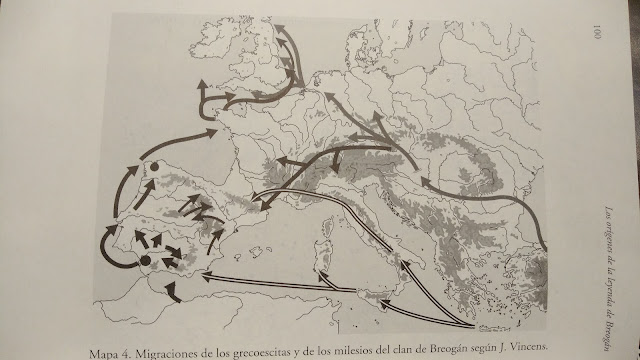Research: In the footsteps of Breogán I
Do you see all those arrows? They are the tests to discover the footprint that the Celtic people have left. Its peculiarity? They all come from the east, so the question is obvious: what ancestors have the Celts we know had?
To "straighten all the arrows in the same direction" I will try to synthesize as much as possible this series of historical events to reveal who Breogán really was. After reading numerous books and texts (bibliography under the text) where this character is named, I have been able to reflect on the reason for his ignorance, even in Galicia (his native land) and his contempt on the part of a part of reactionary society. But these conclusions would give for several pages and the objective of this study is to spread little by little, trying to explain as clearly as possible, the legend of Breogán. Also, it must be said that there are many names, many places in these stories (keep in mind that we will travel thousands of kilometers knowing hundreds of characters, historical and biblical references of a little-known stage of Humanity), so I humbly ask you to train your patience and sharpen your curiosity about the unknown.
----------------------------------------------------------------------------------------------------------
We travel to the 13th century BC
Before we begin, let's take a look at the map. In the 13th century BC, three great territories prevail in their respective regions:
The red color symbolizes the territory of the Scythian peoples or kingdoms, Eurasian nomads with a similar culture and tradition. It is frequent to call it Empire.
The orange color represents Babylon, one of the oldest civilizations ever known, protagonist in the history of the Celtic peoples.
The olive color represents the Egyptian Empire. Of the most characteristic empires of Antiquity, whose pharaohs have been key to the migrations that we will tell later.
(After the Biblical Flood, a possible storm that devastated large populated areas, leaving an indefinite amount of the population of the regions on the map without food or shelter)
In present-day Greece, a small Scythian kingdom has a new heir: Fenius Farsidth, son of the former King Baath. Thanks to the commerce and the "word of mouth" of the merchants with the people who were on the road, the news arrives in the kingdom of the need to build a large tower that can cope with possible storms on the banks of the Tigris River and the Euphrates in Babylon (orange area of the map)
Fenius Farsidth, along with two other men, were the drivers and architects of the construction of the subsequent Nimrod Tower. The reasons why a Scythian king could help to raise this building are unknown, although the indications indicate a commercial reason to favor commercial exchanges.
[Herodotus, the father of History, mentions that tower on his trip to Babylon, whose building would be about 90 meters high and 7 floors smaller and smaller the higher it took]
After a few years supervising the work and staying on the meridians of the Nimrod Tower, Fenius Farsidth becomes a father and his two children are born: Naenbal and Nel.
Naenbal will be the new heir to the Scythian kingdom of the Aegean Sea; Nel, born in the tower itself, will be a name (easy to remember) that should not be forgotten for the events that follow.
After the construction of the great Tower of Babylon is complete, Fenius Farsidth and his men return to the kingdom from which they came: their task has been successfully completed.
References:
Ghabhala, L., & Sánchez, S. R. (2010). Leabhar Ghabhala. The book of the invasions (Basic Pocket) (Spanish Edition) (1st ed.). Madrid, Spain: Ediciones Akal, S.A.
McNair, R. F. (2012). KEY TO NORTHWEST EUROPEAN ORIGINS. AuthorHouse.





Comentarios
Publicar un comentario